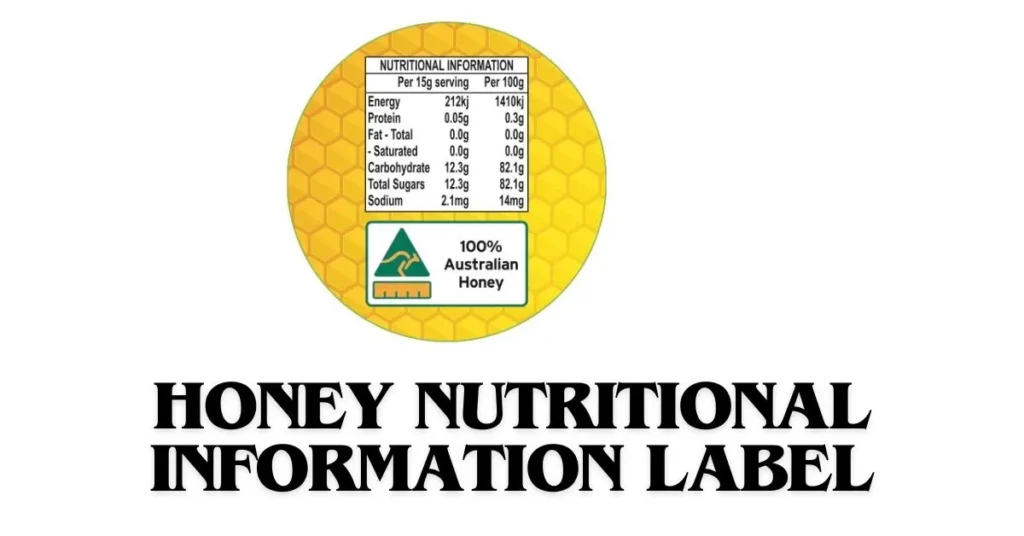Honey has been cherished for its sweet flavor and health benefits for centuries. From drizzling it over your morning toast to stirring it into your tea, honey is a versatile staple in many kitchens. But have you ever taken a closer look at the honey nutritional information label? Understanding what’s in your honey can help you make informed choices about incorporating this natural sweetener into your diet. In this article, we’ll dive deep into the nutritional aspects of honey, helping you decode its label and appreciate its benefits.
The Basics of Honey:
Honey is a natural sweetener produced by bees using nectar from flowers. Its composition can vary depending on the types of flowers visited by the bees, but it generally consists of sugars, water, and trace amounts of vitamins and minerals. Honey’s flavor, color, and aroma can also vary based on its botanical source, ranging from light and mild to dark and robust.
While honey is often seen as a healthier alternative to refined sugar, it’s still important to understand its nutritional profile. Let’s explore what you can typically find on a honey nutritional information label.
Breaking Down the Nutritional Information:
Serving Size:
One of the first things you’ll notice on a honey nutritional information label is the serving size. Typically, a serving size is one tablespoon (21 grams). This standard measure helps in understanding the nutritional content of honey per use.
Calories:
A single tablespoon of honey contains approximately 64 calories. These calories come primarily from carbohydrates. While this might seem high compared to some other sweeteners, honey’s natural sugars and additional nutrients can make it a better choice for some people.
Carbohydrates:
Carbohydrates make up the bulk of honey’s nutritional content. In a tablespoon serving, you’ll find about 17 grams of carbohydrates. This includes:
- Fructose: Around 8 grams
- Glucose: Approximately 7 grams
- Maltose and Sucrose: About 2 grams combined
These natural sugars provide quick energy, making honey a popular choice among athletes and those needing a rapid energy boost.
Sugars:
Out of the total carbohydrates, the sugars in honey are the most significant. A tablespoon typically contains around 17 grams of sugar. While these are natural sugars, it’s still important to consume honey in moderation, especially for individuals monitoring their sugar intake.
Fiber and Starch:
Honey contains no fiber or starch, which means all the carbohydrates in honey are in the form of sugars. This makes it a quickly digestible source of energy but also highlights the need to use it sparingly to avoid excessive sugar consumption.
Vitamins and Minerals:
Trace Vitamins:
Honey is not a significant source of vitamins, but it does contain small amounts of certain vitamins such as:
- Vitamin C: Antioxidant properties
- Vitamin B6: Supports brain health and mood regulation
- Niacin (Vitamin B3): Helps convert food into energy
Minerals:
Honey also contains trace amounts of minerals, including:
- Calcium: Supports bone health
- Iron: Essential for blood production
- Magnesium: Important for muscle and nerve function
- Potassium: Helps maintain fluid balance and supports heart health
- Zinc: Vital for immune function
While these vitamins and minerals are present in small quantities, they add to honey’s nutritional profile, making it more beneficial than many refined sugars.
Health Benefits of Honey:
Antioxidant Properties:
Honey is rich in antioxidants, which help protect your body from oxidative stress and free radicals. These antioxidants include flavonoids and phenolic acids, which can contribute to better health and reduced risk of chronic diseases.
Antimicrobial and Anti-inflammatory Properties:
Honey has natural antimicrobial and anti-inflammatory properties. It has been used historically to treat wounds and burns, thanks to its ability to kill bacteria and promote healing. Some studies suggest that consuming honey can soothe sore throats and reduce inflammation.
Digestive Health:
Honey can aid in digestive health due to its prebiotic properties. It helps promote the growth of good bacteria in the intestines, which can enhance digestion and overall gut health. Additionally, honey is easier to digest compared to some other sweeteners, making it a gentle option for people with sensitive stomachs.
Comparing Honey to Other Sweeteners:
Honey vs. Sugar:
When comparing honey to refined sugar, honey has several advantages. While both provide similar calorie content, honey contains trace vitamins and minerals that sugar lacks. Moreover, the natural sugars in honey are absorbed more slowly by the body, preventing sudden spikes in blood sugar levels.
Honey vs. Artificial Sweeteners:
Artificial sweeteners like aspartame and sucralose have zero calories, making them popular among those looking to reduce calorie intake. However, honey, being a natural product, avoids the potential negative effects associated with artificial sweeteners, such as headaches or digestive issues.
Choosing the Right Honey:
Raw Honey:
Raw honey is honey in its purest form, unprocessed and unheated. It retains more nutrients and beneficial compounds compared to processed honey. When choosing honey, look for raw honey to maximize its health benefits.
Manuka Honey:
Manuka honey, produced in New Zealand from the nectar of the manuka tree, is renowned for its high antibacterial properties. It’s often used medicinally and is available with varying levels of potency, measured by the Unique Manuka Factor (UMF) rating.
Organic Honey:
Organic honey is produced following organic farming practices, ensuring no synthetic pesticides or chemicals are used. This type of honey can be a great option for those looking to avoid contaminants and support environmentally friendly practices.
Incorporating Honey into Your Diet:
Sweetening Beverages:
One of the easiest ways to incorporate honey into your diet is by using it as a sweetener in beverages. Whether you add it to your tea, coffee, or smoothies, honey provides a natural sweetness with added nutritional benefits.
Cooking and Baking:
Honey can be used as a substitute for sugar in many recipes. It adds moisture and a unique flavor to baked goods. When using honey in recipes, remember it is sweeter than sugar, so you might need to use less of it.
Toppings and Dressings:
Drizzling honey over yogurt, oatmeal, or pancakes is a delicious way to enjoy its sweetness. You can also use honey in salad dressings and marinades to add a touch of sweetness and depth of flavor.
Storing and Handling Honey:
Proper Storage:
To maintain honey’s quality and prevent crystallization, store it in a cool, dry place. While crystallization is a natural process, it can be reversed by gently warming the honey in a water bath.
Avoiding Contamination:
Always use a clean, dry spoon to scoop honey to prevent contamination. Avoiding moisture helps preserve honey’s natural properties and prevents spoilage.
Conclusion:
Honey is more than just a natural sweetener; it’s a nutritional powerhouse with numerous health benefits. By understanding the honey nutritional information label, you can make informed choices about how to incorporate this golden elixir into your diet. Whether you use it to sweeten your tea, enhance your baking, or enjoy it straight from the jar, honey offers a delicious and nutritious alternative to refined sugars. So next time you reach for a sweetener, consider the benefits of honey and enjoy its natural goodness.







